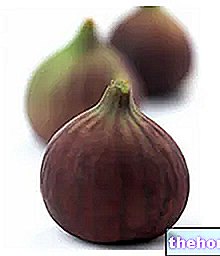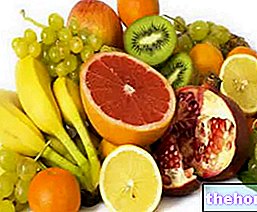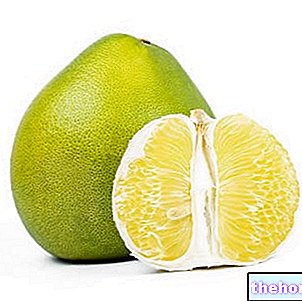So is the Cherimoya
The cherimoya, also written chirimoya, is the fruit of a plant belonging to the Genus Annona, Species cherimola; the binomial nomenclature of this vegetable is Annona cherimola.

The cherimoya is hypothetically native to the American continent, but it is not yet clear whether it comes from the mountainous colony of the Andes or from Central America (where there are numerous similar species).
Today, Cherimoya plants are grown throughout Southern Asia, Central America, South America, Southern California, Portugal, Southern Andalusia and Southern Italy.
Description
That of the cherimoya is an evergreen shrub of modest size (maximum 7m in height). The leaves are alternate, simple, lanceolate, about 7-15cm long and 6-10cm wide. The cherimoya flowers are grouped and small (2-3cm), with six yellow-brown petals, sometimes speckled with purple at the base.
The fruit of the cherimoya is oval, 10-20cm long and about 7-10cm wide; the dimensions are roughly that of a grapefruit. The peel is smooth and only slightly tuberculous. The pulp of the cherimoya is white, with a creamy consistency and possesses numerous easily removable brown seeds in dispersion.
The organoleptic and gustatory characteristics are excellent, also thanks to the typically sweet taste. The overall flavor resembles a mix of banana, pineapple, papaya, peach and strawberry.
Composition for: 100g of Cherimoya

Nutritional values (per 100 g of edible portion)
When fully ripe, the peel is green and gives slightly to digital pressure in a similar way to avocado. Also for this reason, the cherimoya can be eaten cut in two and then emptied with a teaspoon (similar to an ice cream).
Nutritional Characteristics
Cherimoya is a product of plant origin that belongs to the VII food group; like the other foods of this group, it is distinguished by the good content of vitamin C (ascorbic acid).
Cherimoya is an aqueous fruit and performs the same nutritional function as apples, pears, peaches, apricots, pineapples etc., that is, it provides sugars, water and water-soluble vitamins. On the contrary, it differs from coconut, avocado and dried fruit (walnuts, hazelnuts, almonds, pine nuts, pistachios, cashews, pecans, etc.), which provide greater amounts of lipids and fat-soluble vitamins.
The fiber content of cherimoya is good, as is the potassium intake. As regards vitamins, we have already said, ascorbic acid (vitamin C) stands out above all. However, this is a little more than modest intake. , clearly lower than that of citrus fruits or strawberries (which contain 4/5 times more).
The overall nutritional picture of cherimoya does not differ much from the average of sweet fruits and the energy intake is quite important. This food must be consumed in the same portions as grapes (autumn fruit, 150-300g / day), and not in those melon, watermelon or peaches (summer fruit, 250-500g / day).
In addition to its nutritional properties, cherimoya is distinguished by an important phytotherapeutic characteristic, namely the presence of annonacina (acetogenin), a polyphenol. This molecule is known for its antioxidant and anticancer capacity; however, its potentially neurotoxic effect (at high concentrations) is suspected to be responsible for atypical parkinsonian forms observed in Guadeloupe (probably, following chronic and significant exposure).
In addition, the crushed seeds (as well as the bark) of cherimoya have strong VENEFIC capacities and, in quantities of 10 or 20, are deadly.
Select plant Fir Acacia Acerola Sorrel Yarrow Yarrow Yarrow Aconito Adatoda Garlic Agnocasto Agrimonia Alchemilla Alkekengi Aloe Altea Witch Hazel Ammi or Visnaga Pineapple Andrographis Anemone Pulsatilla Angelica Anise Star Anise Japanese Star Anise Bitter Orange Bitter Areca Arnica Harpagophytum Arpagophyte Artemisia Asteragus Basil Asparagus Asparagus Peruvian Asparagus Asparagus Asparagus Hawthorn Boldo Borage Shepherd's Purse Boswellia Bucco Butea superba Cocoa Coffee Cajeput Calamus Calamus Marigold Camedrio Chamomile Roman Chamomile Camphor Cinnamon Ceylon Maidenhair Capuchin Artichoke Cardamom Cardiac Thistle Asian Thistle Carvi Cascara Cassia Catecu Catha Cabbage Celandine Chicory Centaurea Cinnamon Cypress Celandine Chives Cypress Coca Cola Colchico Combreto Condurango Comfrey Coriander Cranberry Barberry American Chrysanthemum Cumin Turmeric Damiana Digital Dioscorea Drosera Dulcamara Dunalilella Echinacea Eder a Ephedra Elenio Eleutherococcus Helichrysum Evening primrose Horsetail Alfalfa Erica Euphrasia Erisimo Escolzia Eucalyptus Farfara Farfaraccio Calabar bean Fenugreek Fennel Phytolacca Frangola Ash Fumaria Japanese Mushrooms Galega Ganoderma lucidum Garcinia Cambogia Mulberry Gentian Broom Ginkgo Guipana Ginkgo Guipana Guipane Gynestra Ginkgo Hibelia Gymnasium Hibelia St. John's Wort Horse Chestnut Ispaghul Hyssop Jaborandi Kava kava Konjac Laminaria Cherry Laurel Lavender Lemongrass Lespedeza Lovage Icelandic Lichen Lemon Linen Lippia Licorice Lobelia Hops Maca Marjoram Maize Mallow Manna Marrubio Marrubio d "water Matè Melaleuca Meliloto Lemon balm MyrtleAmerican Momordica Morus Alba Muira puama Nepeta Niaouli Nigella Walnut Nutmeg Walnut vomica Olive Meadowsweet Ononide Opuntia Oregano Orthosiphon Nettle Poppy Papaya Parietaria Feverfew Passiflora Chilli Perilla Pervinca Phyllanthus Plantain Picrorhiza Pilosella Pino Piscidia Piscidia Pisces Ricino Rodiola Rosehip Rosemary Rue Willow Sarsaparilla Sage Elderberry Sassafras Sedum Ergot Senna Serenoa repens Soybean Solidago spirulina Tamarind Tansy Dandelion Badger Tea Linden Thyme Tormentilla Clover Fibrinous clover Tuia Uncaria Bearberry Valerian Vanilla Verbasco Saffron Verbenae Verbena Ginger Pumpkin Select disease Juvenile acne Acne Rosacea Tinnitus Aerophagia Tendon affections Aphonia Aphtas Functional algae Bad breath Breastfeeding Allergy Anemia Anemia Anxiety Arteriosc lerosis Gouty arthritis Rheumatoid arthritis Arthrosis Asthenia Asthenia Sex Man Asthenia Sex Woman Blepharitis and Conjunctivitis Eye bags Bronchitis Gallstones Kidney stones Salivary stones Baldness Androgenetic Candida Fragile hair Caries Headache Cellulitis Kinetosis Cystitis Climatic therapy Cholecystopathy Ultrasound Cholesterolitis Dermatitis Colesterolitis High cholesterol Dermatoma Contopathy Colesterol Diaper Diaper Diabetes Diarrhea Erectile Dysfunction Dyslipidemia Dysmenorrhea Dyspepsia Disturbed Vision Haemorrhoids Epistaxis Cardiac Erethism Fever Fibromyalgia Flatulence Phlebitis Gastritis Chilblains Gingivitis Herpes Loss of appetite Urinary infections Influenza Insomnia Hypersomnia Irritable bowel Malthritis Hypertension Hypertension Hypertension Hypertension Hypersomia Alzheimer's disease Crohn's disease Nausea Vomiting Obesity Dark circles Onychomycosis Osteoporosis Dry skin Periarthritis Piorrea Pres Low sion Prostatitis Psoriasis Cold Breast fissures Anal fissures Gastroesophageal reflux Nasopharyngitis Rolls (abdominal fat) Wrinkles Salmonella Senescence Premenstrual syndrome Sinusitis Quit smoking Overweight Fatty liver Constipation Stomatitis Stress Cough High triglycerides Ulcer Burns Nails Abdominal pain Vampires aphrodisiac bittering analgesic anesthetic anorectics antacid analgesic anti-asthmatic Antibiotic allergy catarrh Anticellulitiche anticonvulsant Antidiaforetiche edematous anthelmintic antidiarrheal antiemetic Antiemorroidarie antiphlogistic Antiidrotiche Antinevrotiche Antioxidants antipyretic antirheumatic antiscorbutic Antiseptic antispasmodic anti-uric Flavoring Aperitive astringent Balsamic Bechiche Capillarotrope cardiotonic Carminative Cathartic caustics Cicatrizant cholagogue choleretic Dyes Decongestants Deodorants purifying Detergents diaphoretic Disinfectants Detox Refreshing Diuretic Exciting emetic emmenagoghe Emollients Haemostatic Energy Epatoprotettrici Expectorants eupeptic photosensitizing Galattofore Galattofughe Galattogoghe Moisturizers Immunostimulators hypertensive Hypnotic Hypoglycemic hypotensive irritant laxative Soothing Narcotic Nervine Nutrients Odontalgiche Pectoral Purgatory revulsive mineralizing fresheners rubefacient Scialagoghe Sedative soporific Starnutatorie stomachic stomatal Narcotics Tenifughe Tonic vasoconstrictor Vasodilators Vermifugees Vesicatory Vitamins Vulnerary Other Foods - Fruits Apricots Sour cherries Cashews Pineapple Watermelon Orange Avocado Banana Persimmon Persimmon Apple Chestnuts Cedar Cherries Coconut Watermelon Dates Feijoa Figs of India Figs Strawberries Berries Passion fruit (Maracujà Giuggi, Granadillawi) of Almond Lime Lemons Mandaranci Mango Apples Quinces Pomegranate Melon Blackberries Mustard Medlar Olives Taggiasca Olives Fermented Papaya Pears Peaches Plantains (Cooking Bananas) Pomelo Grapefruit Pink Grapefruit Plums, prunes Fruit juices and fruit juices Grape juice Plums Grapes Sultanas and Raisins OTHER FRUIT ITEMS Categories Food Alcoholics Meat Cereals and derivatives Sweeteners Sweets Offal Fruit Dried fruit Milk and derivatives Legumes Oils and fats Fish and fishery products Salami Spices Vegetables Health recipes Appetizers Bread, Pizza and Brioche First courses Second courses Vegetables and Salads Sweets and Desserts Ice creams and sorbets Syrups, liqueurs and grappas Basic Preparations ---- In the Kitchen with Leftovers Carnival Recipes Christmas Recipes Diet Recipes Light Recipes Women's Day, Mother's Day, Dad's Day Functional Recipes International Recipes Easter Recipes Recipes for Celiacs Recipes for Diabetics Recipes for the Holidays Recipes for Valentine's Day Recipes for Vegetarians Recipes proteic he Regional Recipes Vegan Recipes




























